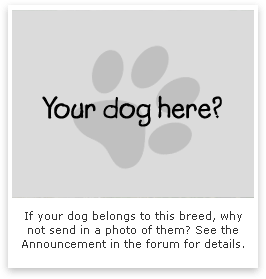OriginThe Pyrenean Mastiff is believed to be descended from dogs brought from Sumeria and Assyria to Spain by the Phoenicians some 3,000 years ago. The breed was developed in the Aragon-Navarra region of the Pyrenees to accompany large flocks of sheep on their annual movement to and from winter and summer pasture and to guard and protect the flocks from predation by wolves and bears. They were also used to protect persons and property. By the 1940s the Pyrenean Mastiff was facing extinction. All the wild predators had been eradicated, rail shipment of sheep became the norm and the deprivations of both a civil war and World War II made food scarce. A large dog with no economic role to play maintenance of the PM became a financial burden and the numbers of pure-bred animals diminished significantly. Fortunately the plight of these magnificent dogs came to the attention of a few dedicated Spanish enthusiasts and, from a groups of 30 pure PMs, they were able to build up the population and successfully promote the breed as an excellent companion. The Pyrenean Mastiff is also known as the Mastin del Pireneo or the Mastin d’Aragon and was first recognized by the Kennel Club in 2001.
Character:The Pyrenean Mastiff has a calm, confident appearance and a very stable temperament. He is extremely affectionate and loyal to his family. He enjoys human company and has a special fondness for, and gentle way with, children. However, his size and his propensity to give a paw, can cause accidental hurt to small children during play. He is a most dependable guard and his watchdog qualities tend to be of the silent sentinel type, barking when only absolutely necessary. He is inclined to be very wary of strangers until introduced, but he is not a gratuitously aggressive dog. He will however fiercely protect that which he feels is his responsibility to defend, be it persons or property, should any threat present itself - and he is a most formidable force when aroused. While he is rarely the instigator of trouble with other dogs he will never back down if challenged and he will also defend his territory from unwelcome animal intruders of any species with surprising swiftness of movement. The passivity of his appearance conceals a watchful and always alert nature. In common with most of the flock guardian breeds the PM will frequently select a high vantage point and lay for hours, vigilant and ready to act should any untoward movement occur in his territory. This can be an excellent family dog, content to spend time watching over and in the company his human 'flock', but is not recommended for novice owners or those with limited outdoor space
Exercise:This is a fairly relaxed breed, content to wander around a property checking out that all is well, but they can turn on the energy if a game is offered or something unusual happens which needs investigating. A daily walk for the sake of physical fitness and to provide new and interesting smells and sights, plus some interactive games, is sufficient for the adult. Puppies should not be taken on long walks or involved in any vigorous exercise whilst their bones and joints are developing. Over-exercise in such a large breed puppy can cause long-term and crippling problems in later life.
Training:It is important that the Pyrenean Mastiff receives at least basic obedience training from an early age. Good verbal control must be established as it would be physically impossible for most people to restrain a PM intent on pulling or lunging on the lead. Also, in the interest of safety and good manners, the dog should be taught the ‘sit’ and ’drop’ and to refrain from jumping up on people to greet them. Training should be carried out by positive reinforcement of good behaviour with rewards of treats or a favourite toy to play with. Harsh negative methods are unnecessary and will result in a dog who is nervous, anxious and confused. Socialization with people, other animals and to accustom the dog to various situations and social experiences will help to prevent unwanted aggression or fearfulness.
|
KC Group:
Working
KC, AKC, FCI recognized?
Yes, no, yes
Size:
Extra Large
Height:
Dogs: minimum 77 cm (30 ins)
Bitches: minimum 72 cm (28 ins). Greater height is usual and preferred
Weight:
54.5 - 79 kg (120 - 175 lbs). Dogs being heavier and more massive than bitches
Colour:
White base with patches of black, gray, sand, marbled, brown, or gold. Mask of same colour as patches
Lifespan:
10 - 12 years
Coat:
Moderately long, coarse, dense, weatherproof
Grooming:
Moderate
Health issues:
Entropion, ectropion, inflammatory bowel disease, hip dysplasia, panosteitis, jaw abnormalities, susceptible to bloat

|











